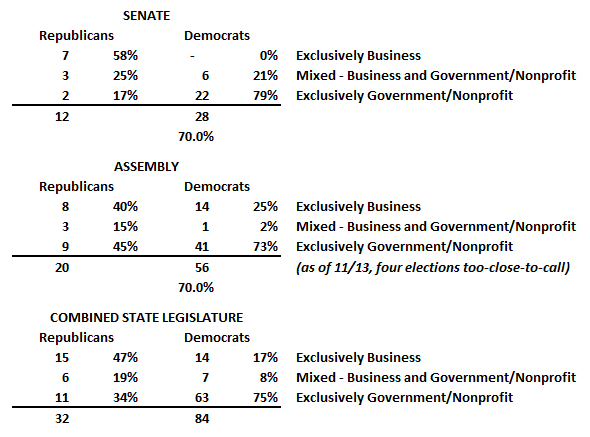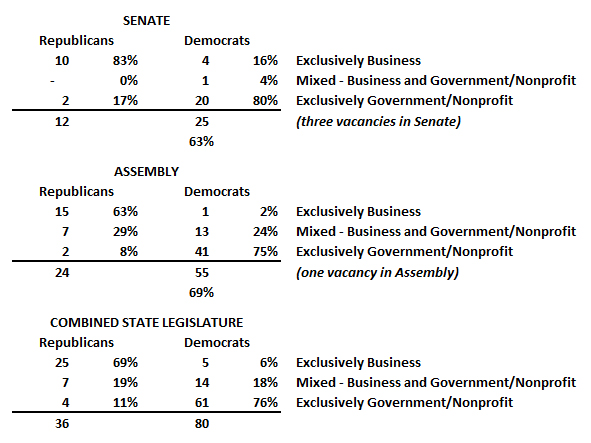California’s Legislators Lack Private Sector Experience
Back in the days of adding machines and manual ledgers, final election results in California were usually done by midnight on election day. Sometimes there would be a few precincts counting ballots into the wee hours of the morning, and you wouldn’t know a result till the next day. Fast forward to 2018, and the age of global interconnectedness, with instantaneous algorithmic management of everything from power grids to Facebook feeds, yet here in California the complete results of the 2018 midterms won’t be available until December 7th. Go figure.
While California’s ability to count ballots runs contrary to the otherwise dazzling march of progress, by now we have enough information to offer a pretty good look at California’s state legislature for 2019-20. The Democratic supermajority has been reestablished. With 28 confirmed seats in the Senate, and 56 in the Assembly, the Democrats hold 70 percent of the seats in both houses. Even if Republicans achieved the unlikely capture of all four Assembly seats that remain too close to call, nothing would change. Overall, so far there are 84 Democratic legislators, and only 32 Republicans.
How Many State Legislators Have Private Sector Experience?
Three election cycles ago, a California Policy Center analysis compared the biographies of California’s state legislators, asking how Republicans and Democrats differ in terms of what they did before they became politicians. To repeat this exercise, 2018 election results were obtained from the California Secretary of States “District Races” page for the Senate and the Assembly. For incumbents who were reelected, biographies were obtained from the Senate and Assembly websites. For newcomers, a trip to Wikipedia, Ballotpedia, or their campaign websites was sufficient.
When one considers the professional background of California’s politicians, a clear pattern emerges. And while compiling this data requires some degree of subjective interpretation, no reasonable interpretation would fail to reveal dramatic differences in experience between Democrats and Republicans.
California State Legislature, 2019-2020 Membership
Business vs. Government Background

As seen on the above table, in California’s 2019-20 state senate, 79 percent of the Democrats have no private sector experience. On the other hand, 58 percent of the Republicans had no public sector experience prior to running for elected office, although most of them ran for local offices prior to running for state senate. The same story applies with California’s state assembly, where 73 percent of the Democrats have no private sector experience, and 55% of the Republicans have at least some private sector experience.
Before continuing, it’s interesting from this perspective to compare this 2019-20 state legislature to the 2013-2014 state legislature. Back then the proportions were generally the same, but there were almost no Democrats – only five in both houses – compared to 14 of them today. Conversely, back in 2013 there were 25 Republicans who had an exclusively business background prior to holding elected office, compared to only 15 today. Over the same period, the number of Republicans with only public sector experience prior to holding office has more than doubled, from four back in 2013 to 11 today. Overall there are now even fewer Republicans – down from a paltry 36/120 six years ago to a vanishing 32/120 today.
California State Legislature, 2013-2014 Membership
Business vs. Government Background

What might explain this tepid drift to the center, at least in terms of more Republican state legislators with public sector experience, and more Democratic state legislators with private sector experience?
One explanation could be the open primary, which makes it less likely an extreme candidate will survive the general election. Another could be the decision made around 2010 by California’s beleaguered business community to start supporting pro-business Democrats. Finally, as Republicans in California fade further into irrelevance, the alliances and allegiances formed in public sector work offer Republican candidates with that background a better chance of electoral success.
Public Sector Unions Pick Public Sector Careerists to Run for Public Office
Back in the 1950’s and 1960’s there were plenty of pro-business Democrats, so called “Pat Brown” Democrats, who worked with Gov. Brown Sr. to build freeways, bridges, power plants, and the finest system of water storage and conveyance the world had ever seen. Those same Democrats cooperated with Republican Governor Reagan a few years later to build the finest public university system in the world. The opportunities available to California’s middle class were unrivaled. What happened to these Democrats?
The problems began in the 1970’s when public sector unions were allowed to form. Steadily acquiring political power through automatic dues deductions, they used taxpayer’s money to lobby for the interests of government workers instead of the interests of the people they serve. Increasingly, business-backed candidates started losing races to candidates backed by government unions. Almost invariably, unions backed Democratic candidates. The more powerful these union-backed candidates became, the more laws they enacted to further consolidate their power. Today government union rule in California is absolute.
The tragedy of unionized government is not merely that they have taken over California’s state legislature and nearly every city, county and school board in the state in order to pursue their membership’s interest above the public interest. It is that most elected officials no longer understand business. These union anointed elected officials come from government agencies, union bureaucracies, nonprofits, activism, and public education. Most of California’s legislators have never had to balance a budget, make a payroll, or convince a customer to voluntarily purchase a product so they could earn a precarious profit in a competitive market.
California’s lawmakers, to the extent they are elected with the support of public sector unions and to the extent they lack business experience, not only face a conflict of interests every time they have to deal with a reform that threatens the power of the unions. They are also less qualified to understand the financial and operational realities that apply in any efficiently ran, productive organization, large or small. They are in over their heads.
To exemplify this, consider how California’s democrats are crowing over a $6 billion budget surplus. Compare that $6 billion surplus to the nearly half-trillion in bond debt that California’s state and local governments have piled up, including another $23 billion on Nov. 6th. Compare that $6 billion surplus to, by most reasonable estimates, the more than half-trillion in unfunded retirement benefits that are going to blow sky high in the next market downturn.
Hint. A trillion is a thousand billion.
* * *
